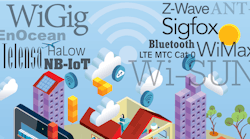Do you know how many wireless standards there are? More than you think. Just recently I made a list of all the short-range wireless standards I could think of—more than 30 in total. I did not include any proprietary designs that fit things like garage door openers, remote keyless entry on vehicles, weather stations, tire pressure monitoring, or all those other unique ISM band wireless devices.
That got me to thinking about how an engineer chooses a standard for his or her application. The first hurdle is just to be aware that all these standards exist. The textbooks and magazines may cover the more popular standards, but none that I have run across cover them all. Then once you know the scope of what exists, how do you choose? You would like to think that the more choices the better. Yet many people think too many choices is bad, and I tend to agree with this. The greater the number of alternatives, the more complex the comparison and selection process is. Less is more, as they say.
Anyway, we have the IoT movement to thank (or curse) for this abundance of choices. For your enlightenment, I have compiled a comprehensive list that will at least give you the awareness you need to stimulate your design selection.
- ANT+
- Bluetooth (Multiple versions 4.0/4.1/4/2/5.0/LE)
- C-V2X (Vehicle communications standard)
- EC-GPRS
- EnOcean
- HaLow (Wi-Fi version 802.11ah)
- Ingenu
- ISA 100.11a
- LoRaWAN
- LTE MTC Cat 0 (cellular)
- LTE eMTC Cat M (cellular)
- MiWi
- NB-IoT
- Near Field Communications (NFC)
- Positive Train Control
- Sigfox
- Telensa
- Thread
- WAVE (Wi-Fi version 802.11p or DSRC for vehicle communications)
- Weightless (Multiple versions N, P, W)
- White Space (Wi-Fi version 802.11af)
- Wi-SUN
- Wi-Fi (Multiple versions 802.11a/b/g/n/ac/ax)
- WiGig (802.11ad)
- WiMAX
- WirelessHART
- ZigBee
- Z-Wave
Impressive, huh? And I have probably forgotten some. Just remember the whole idea here is that you become aware of your options. As I said earlier, there are probably more than you realized.
The bulk of applications today are either Bluetooth or Wi-Fi (802.11)-based. These are well-known standards and offer compatibility with existing Wi-Fi access points/routers and Bluetooth gateways. There are multiple choices within each standard to best match up with your application. All the other standards have been used somewhere with success, but do they meet your needs?
Several of the standards are based upon the IEEE 802.15.4 standard and some with an enhancement called 6LoWPAN. These are Thread, ISA100.11a, and Wi-SUN. ZigBee, Wireless HART, and ISA100a seem to be best for industrial uses. Z-Wave seems best for home use, but ZigBee also fits there. Longer-range 802.11af or 802.11ah and Weightless seem to be good choices for remote monitoring. The 802.11af and Weightless W standards use the abandoned television channels called TV White Space. And then there are all the newer cellular-based standards using LTE that require cellular service in addition to their ability to communicate directly.
Anyway, if you are trying to decide, here are a dozen key questions to ask as you do your design comparisons and due diligence.
- What is the maximum range of a link?
- What is the maximum data rate used in the application?
- Is power consumption an issue?
- What is the frequency band of operation?
- How many nodes are to be used? Is a large network needed?
- What other wireless services/devices are nearby that could cause interference?
- Are licensing and certification required to use the standard?
- Are chips and/or modules available from multiple vendors?
- Are related connections such as cellular services needed?
- Are reference designs, development kits, and other design support available?
- Is your application unique? Maybe you do need to create your own standard with RF in one of the ISM bands with a protocol optimized for your use cases.
- How big a factor is cost to develop, deploy, and maintain?
That is probably not the end of it. We can look forward to even more standards in the future. Somewhere there is a group of engineers creating a new wireless standard as you read this, like a new Wi-Fi variant or Bluetooth 6. But that’s not all: We can look to the forthcoming 5G New Radio system standards to provide not only future cellular and fixed wireless services, but also to serve many short-range wireless applications like IoT, M2M, and others.

